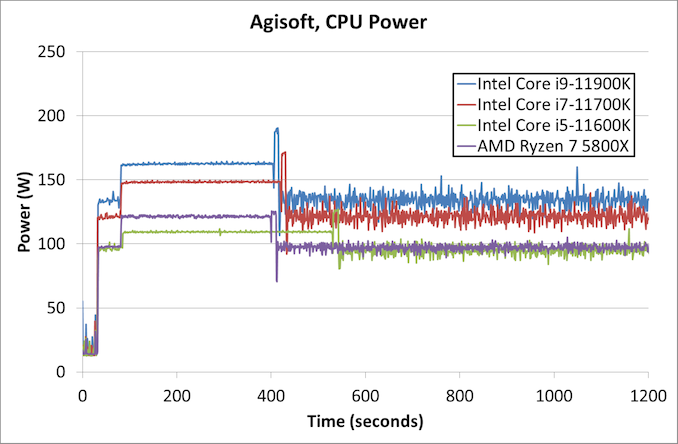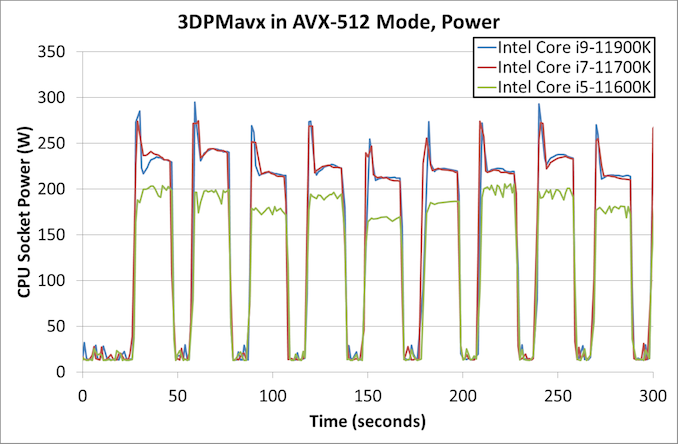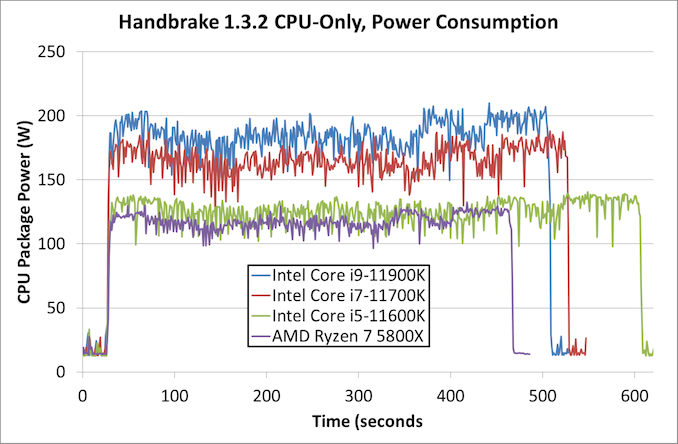Intel Rocket Lake (14nm) Review: Core i9-11900K, Core i7-11700K, and Core i5-11600K
by Dr. Ian Cutress on March 30, 2021 10:03 AM EST- Posted in
- CPUs
- Intel
- LGA1200
- 11th Gen
- Rocket Lake
- Z590
- B560
- Core i9-11900K
Power Consumption: AVX-512 Caution
I won’t rehash the full ongoing issue with how companies report power vs TDP in this review – we’ve covered it a number of times before, but in a quick sentence, Intel uses one published value for sustained performance, and an unpublished ‘recommended’ value for turbo performance, the latter of which is routinely ignored by motherboard manufacturers. Most high-end consumer motherboards ignore the sustained value, often 125 W, and allow the CPU to consume as much as it needs with the real limits being the full power consumption at full turbo, the thermals, or the power delivery limitations.
One of the dimensions of this we don’t often talk about is that the power consumption of a processor is always dependent on the actual instructions running through the core. A core can be ‘100%’ active while sitting around waiting for data from memory or doing simple addition, however a core has multiple ways to run instructions in parallel, with the most complex instructions consuming the most power. This was noticeable in the desktop consumer space when Intel introduced vector extensions, AVX, to its processor design. The concurrent introduction of AVX2, and AVX512, means that running these instructions draws the most power.
AVX-512 comes with its own discussion, because even going into an ‘AVX-512’ mode causes additional issues. Intel’s introduction of AVX-512 on its server processors showcased that in order to remain stable, the core had to reduce the frequency and increase the voltage while also pausing the core to enter the special AVX-512 power mode. This made the advantage of AVX-512 suitably only for strong high-performance server code. But now Intel has enabled AVX-512 across its product line, from notebook to enterprise, with the running AI code faster, and enabling a new use cases. We’re also a couple of generations on from then, and AVX-512 doesn’t get quite the same hit as it did, but it still requires a lot of power.
For our power benchmarks, we’ve taken several tests that represent a real-world compute workload, a strong AVX2 workload, and a strong AVX512 workload.
Starting with the Agisoft power consumption, we’ve truncated it to the first 1200 seconds as after that the graph looks messy. Here we see the following power ratings in the first stage and second stage:
- Intel Core i9-11900K (1912 sec): 164 W dropping to 135 W
- Intel Core i7-11700K (1989 sec): 149 W dropping to 121 W
- Intel Core i5-11600K (2292 sec): 109 W dropping to 96 W
- AMD Ryzen 7 5800X (1890 sec): 121 W dropping to 96 W
So in this case, the heavy second section of the benchmark, the AMD processor is the lowest power, and quickest to finish. In the more lightly threaded first section, AMD is still saving 25% of the power compared to the big Core i9.
One of the big takeaways from our initial Core i7-11700K review was the power consumption under AVX-512 modes, as well as the high temperatures. Even with the latest microcode updates, both of our Core i9 parts draw lots of power.
The Core i9-11900K in our test peaks up to 296 W, showing temperatures of 104ºC, before coming back down to ~230 W and dropping to 4.5 GHz. The Core i7-11700K is still showing 278 W in our ASUS board, tempeartures of 103ºC, and after the initial spike we see 4.4 GHz at the same ~230 W.
The Core i5-11600K, with fewer cores, gets a respite here. Our peak power numbers are around the 206 W range, with the workload not doing an initial spike and staying around 4.6 GHz. Peak temperatures were at the 82ºC mark, which is very manageable. During AVX2, the i5-11600K was only at 150 W.
Moving to another real world workload, here’s what the power consumption looks like over time for Handbrake 1.3.2 converting a H.264 1080p60 file into a HEVC 4K60 file.
This is showing the full test, and we can see that the higher performance Intel processors do get the job done quicker. However, the AMD Ryzen 7 processor is still the lowest power of them all, and finishes the quickest. By our estimates, the AMD processor is twice as efficient as the Core i9 in this test.
Thermal Hotspots
Given that Rocket Lake seems to peak at 104ºC, and here’s where we get into a discussion about thermal hotspots.
There are a number of ways to report CPU temperature. We can either take the instantaneous value of a singular spot of the silicon while it’s currently going through a high-current density event, like compute, or we can consider the CPU as a whole with all of its thermal sensors. While the overall CPU might accept operating temperatures of 105ºC, individual elements of the core might actually reach 125ºC instantaneously. So what is the correct value, and what is safe?
The cooler we’re using on this test is arguably the best air cooling on the market – a 1.8 kilogram full copper ThermalRight Ultra Extreme, paired with a 170 CFM high static pressure fan from Silverstone. This cooler has been used for Intel’s 10-core and 18-core high-end desktop variants over the years, even the ones with AVX-512, and not skipped a beat. Because we’re seeing 104ºC here, are we failing in some way?
Another issue we’re coming across with new processor technology is the ability to effectively cool a processor. I’m not talking about cooling the processor as a whole, but more for those hot spots of intense current density. We are going to get to a point where can’t remove the thermal energy fast enough, or with this design, we might be there already.
I will point out an interesting fact down this line of thinking though, which might go un-noticed by the rest of the press – Intel has reduced the total vertical height of the new Rocket Lake processors.
The z-height, or total vertical height, of the previous Comet Lake generation was 4.48-4.54 mm. This number was taken from a range of 7 CPUs I had to hand. However, this Rocket Lake processor is over 0.1 mm smaller, at 4.36 mm. The smaller height of the package plus heatspreader could be a small indicator to the required thermal performance, especially if the airgap (filled with solder) between the die and the heatspreader is smaller. If it aids cooling and doesn’t disturb how coolers fit, then great, however at some point in the future we might have to consider different, better, or more efficient ways to remove these thermal hotspots.
Peak Power Comparison
For completeness, here is our peak power consumption graph.

Platform Stability: Not Complete
It is worth noting that in our testing we had some issues with platform stability with our Core i9 processor. Personally, across two boards and several BIOS revisions, I would experience BSODs in high memory use cases. Gavin, our motherboard editor, was seeing lockups during game tests with his Core i9 on one motherboard, but it worked perfectly with a second. We’ve heard about issues of other press seeing lockups, with one person going through three motherboards to find stability. Conversations with an OEM showcased they had a number of instability issues running at default settings with their Core i9 processors.
The exact nature of these issues is unknown. One of my systems refused to post with 4x32 GB of memory, only with 2x32 GB of memory. Some of our peers that we’ve spoken to have had zero problems with any of their systems. For us, our Core i7 and Core i5 were absolutely fine. I have a second Core i9 processor here which is going through stability tests as this review goes live, and it seems to be working so far, which might point that it is a silicon/BIOS issue, not a memory issue.
Edit: As I was writing this, the second Core i9 crashed and restarted to desktop.
We spoke to Intel about the problem, and they acknowledged our information, stating:
We are aware of these reports and actively trying to reproduce these issues for further debugging.
Some motherboard vendors are only today putting out updated BIOSes for Intel’s new turbo technology, indicating that (as with most launches) there’s a variety of capability out there. Seeing some of the comments from other press in their reviews today, we’re sure this isn’t an isolated incident; however we do expect this issue to be solved.













279 Comments
View All Comments
blppt - Tuesday, March 30, 2021 - link
I disagree. I had a 9590 (which shipped WITH a small AIO cooler!) and the thing was shaky at best for stability, easily topping 90c at stock settings.Not the mobo fault either, I had the top end ASUS CHVF-Z 990FX, which was such a mature chipset it practically had grey hairs.
TheinsanegamerN - Wednesday, March 31, 2021 - link
the 9000 series all had stability issues. Backing off 1 clock bin or tinkering with voltage would usually fix them.Bulldozer didnt have the thermal density issues modern CPUs have. If you had the cooling, it would work. Bulldozer's issue was the sheer amount of heat being being generated would overwhelm many CPU coolers of the time, which were built aroudn the more tradiitonal ~100w power draw of intel I7s and the ~125-140 of phenoms. The 200+ that bulldozer was pulling was new territory.
Oxford Guy - Wednesday, March 31, 2021 - link
Certain motherboard makers played loose with the VRMs. AsRock in particular was known for its 9000-series-certified boards frying. MSI was also bad. Only a few boards were suited to the 9000 series and any enthusiast would have skipped the 9000 series in favor of one of the lower-leakage chips, which could be overclocked to the same 4.7 GHz. 5 GHz with Piledriver was not stable, requiring too much voltage. ASUS tried to hide that by under-reporting the voltage used in its flagship board. 4.4 GHz was optimal, 4.5 was okay, and 4.7 was as far as one wanted to go for frequent use. That's with the lower-leakage 'E' parts."The Stilt" said AMD would have sent the 9000 series to the crusher had it not come up with an after-the-fact lower standard for leakage. So, Hruska gets his take spectacularly wrong in his Rocket Lake article. The 9000 series was not aimed at 'the enthusiast faithful'. Those people knew better than to buy a 9000 series chip, even though there were a few astroturfers trying to get people to buy them — like one guy who claimed his was running at 5.1 GHz 24/7.
It was aimed at people who could be tricked by the 5 Ghz number. It was the most cynical cash grab possible. Not only did AMD offer only 4 FPU cores (important for gaming) it offered a CPU that was priced into the stratosphere while having un-fixable single-core performance.
Piledriver's fatal flaw was its abysmal single-thread performance, not its power consumption. It could have been okay enough with the lower-leakage standard (and a more strict socket standard as Zen 1 had). But, reportedly, the 32nm SOI wasn't very good for some time (Bulldozer and the first generation of Piledriver), so AMD let the AM3+ spec be pretty loose (although not as loose as FM).
Overclocking Piledriver even to 5 GHz wasn't enough to give it decent single-thread performance.
I do have to agree that the 9590 was the single worst consumer CPU product ever released. It even edges out the Pentium III that wasn't stable — since that one was actually pulled from the market. Not only was the 9590 100% cynical exploitation of consumer ignorance, it was really bad technologically. Figures that Hruska would praise it.
(If, though, one lived in Iceland with a solar array backed by an iron-nickle battery complex, the 9590 would have been okay for playing Deserts of Kharak, provided one didn't buy it at its original price.)
blppt - Thursday, April 1, 2021 - link
"Those people knew better than to buy a 9000 series chip, even though there were a few astroturfers trying to get people to buy them — like one guy who claimed his was running at 5.1 GHz 24/7."What is especially sad here is that even IF he managed to pump the 250-300W into that 9590 to run at 5.1 (all cores), it was probably still slower than a 4790K at stock speeds.
Oxford Guy - Saturday, April 3, 2021 - link
In single core, certainly. However, 2011 is stamped onto the spreaders of Piledriver and it hit the market in 2012. The 4790K hit the market in Q2 2014.In 2014, the only FX to consider was the 8320E. Not only was it cheap (at least at MicroCenter), it could run in any AM3+ board without killing it — and could be overclocked better than a 9000 series with anything below nitrogen, due to its much superior leakage.
The 8320E was the only FX worth anyone’s time. Paired with a UD3P board it could do 4.4 GHz readily and could manage 4.7 with a fast fan angled at the VRM sink. Total cost was very low for the CPU and board from MicroCenter, which is why I recommended that setup to the tightest budget people. But, the bad single core was a problem for frametime consistency.
AMD should have been publicly tarred and feathered by the tech press for the 9590. All the light mockery wasn’t enough.
Spunjji - Friday, April 9, 2021 - link
Broadly agreed, but I'd note that the 6300 was also reasonable if you were on a painfully low budget. I suggested it to a friend (his alternative was a Sandy Bridge i3) and it lasted him until a year back as his main gaming system. It's now moved on to another friend, who still uses it for games. Those chips have aged surprisingly well, all things considered, though it is probably holding his RX 470 back a little bit.Oxford Guy - Wednesday, March 31, 2021 - link
• The 9590 posted the highest results in the game Deserts of Kharak, in a dual 980 Ti setup at only 1080 or 1440. And, SLI setups showed competitive 4K scores for many games back then.• The overclocked 'The Stilt' said the 9000 series is not the chip to judge the design by because it has the worst leakage characteristics and would have been sent to the crusher had AMD not decided to create a lower standard after the fact. Instead, the chips that should be used to represent Piledriver are the 'E' series. They have the lowest leakage and can manage the same 4.7 GHz the 9590 uses with much more reasonable (although still non-competitive) demands. The 9000 series was really AMD's gift to Intel, by making the bad ancient Piledriver design look much worse.
• AMD was a small cash-strapped company, thanks to Intel's monopoly abuses. When AMD was leading the x86 industry Intel kept it from getting the profit. So, Piledriver, although very bad in a number of ways, will never be as bad as Rocket Lake. The 9000 series is the only exception, though, since it was a purely cynical cash grab by AMD, using '5 GHz' to sucker people.
blppt - Thursday, April 1, 2021 - link
"The 9590 posted the highest results in the game Deserts of Kharak, in a dual 980 Ti setup at only 1080 or 1440. And, SLI setups showed competitive 4K scores for many games back then."As I stated, in the (exceedingly rare) case where a game or app can saturate all 8 cores, when the 9590 was in its prime, it could be competitive.
That almost never happened, especially in games. About the only 2 I can think of offhand that could do that in the 9590's prime was GTA5 and Company of Heroes 2. And even then, you were using 150+ more watts to get the same or slightly better performance than Intel's high-end quad cores. Along with the required AIO water cooling and required high-end mobo with a beastly VRM setup. As far as I know, only 3 pricey mobos were approved for the 9590, my CHVF-Z, one Gigabyte board, and an ASRock.
9590 was one of the worst cpus ever. Probably the single worst (special edition) cpu. I had one for years.
This rocket lake, while disappointing, hot, and power consuming, is consistently competitive in every game versus its direct competitors. The 9590 cannot come close to saying that.
Oxford Guy - Saturday, April 3, 2021 - link
I cite Desert of Kharak because it’s the only game I’ve seen put the FX ahead of Intel at below 4K.Not only would the game need to be able to leverage 8 integer cores without needing more than 4 FPU cores, it would have to be able to saturate a narrow deep pipeline and not rely heavily on single thread IPC. It should also scale with clock and not need the best RAM and L3 performance. RTS is probably the best genre for the Piledriver design.
Gondalf - Tuesday, March 30, 2021 - link
AMD FX-9590 had not AVX-512. Very high performance have a cost.Try to image Zen 3 with AVX-512, it could not be a champion in low power consumption at all.
If you do not like high power draw, simply disable AVX-512.